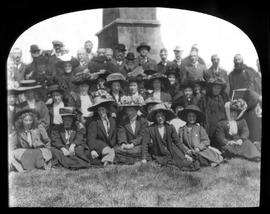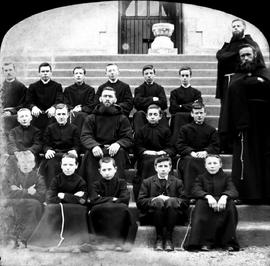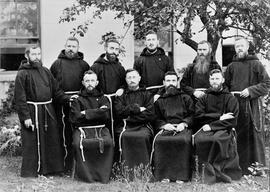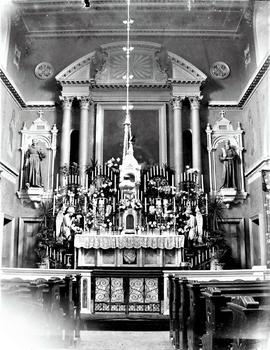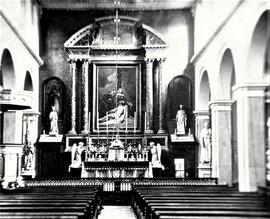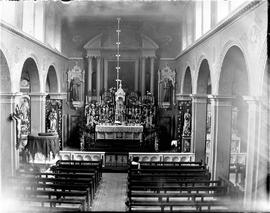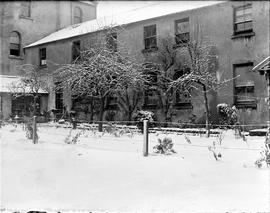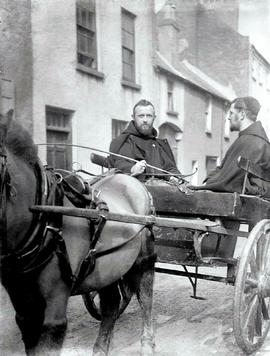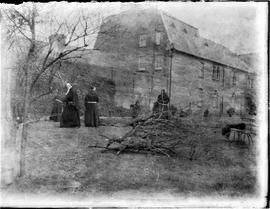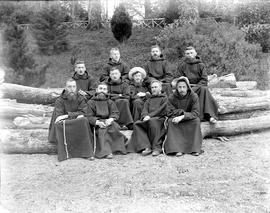Cote
Titre
Date(s)
- c.1870-c.1935 (Création/Production)
Niveau de description
Étendue matérielle et support
21 boxes, comprising 307 Glass Plate Negatives, Glass Stereo Plates and Lantern Slides
Nom du producteur
Notice biographique
Patrick Healy was born on 26 February 1875 in Graiguenamanagh, a small town on the border between Counties Carlow and Kilkenny. He entered the Capuchin novitiate at Rochestown in County Cork on 7 July 1894 and took the religious name of Angelus. He took his solemn vows in December 1897 and was ordained a priest in February 1902. Fr. Angelus cultivated a life-long interest in the history of the Irish Capuchins. In 1904, he worked alongside Fr. Stanislaus Kavanagh OFM Cap. (1876-1965) in transcribing autograph copies of two seventeenth century histories of the Irish friars by Nicholas Archbold ‘The historie of the Irish Capucins’ (1643) and Robert O’Connell ‘Historia Missionis Hiberniae Fratrum Minorum Capucinorum’ (c.1654). The original texts had been brought from France to the National Library of Ireland in Dublin for copying. Fr. Angelus was considered an authority on the history of the Irish Capuchin Province, and in 1919 he was chosen as a witness in the beatification cause of two seventeenth-century Capuchin martyrs, Fr. Fiacre Tobin OSFC (c.1620-1656) and Fr. John Baptist Dowdall OSFC (c.1626-1710). He also held several important administrative positions in the Irish Province. Three times he was elected as definitor (or counsellor), from 1910-3 and from 1922-5. He also held the position of Vicar-Provincial and was elected Custos General in 1913 which enabled him to attend the General Chapter of the Order in Rome. He was appointed Guardian of the Church Street Friary and was, at various times, Master of Novices, editor of ‘The Father Mathew Record’ periodical, and director-general of the Total Abstinence Association. Fr. Angelus never considered himself an academic historian but throughout his life he worked assiduously to assemble a vast corpus of documentary records on the history of the friars in Ireland. His ‘Pages from the Story of the Irish Capuchins’, published in 1915 to mark the tercentenary of the arrival of the first friar in Ireland, offered a concise introduction to the subject. ‘The execution of a more scholarly work’, he claimed, demanded ‘more patient research than he could ever command’. Known as an able missionary and preacher, he was also acclaimed as the ‘Guardian of the Reek’ in honour of his long association with the annual Croagh Patrick pilgrimage in County Mayo. His association with Croagh Patrick (also called ‘St. Patrick’s Reek’) lasted from 1906 to 1949, during which he climbed the mountain forty-two times missing only two years, in 1919 due to a railway strike, and in 1922 due to the Civil War. He died at the Presbytery in Westport Parish at the foot of Croagh Patrick on 20 August 1953. He was buried in the Capuchin plot in Glasnevin Cemetery in Dublin.
Histoire archivistique
Source immédiate d'acquisition ou de transfert
Portée et contenu
The collection comprises over 300 original glass plate negatives and lantern slides. Prior to the invention of cellulose nitrate film in 1903, photographic emulsions were made on glass supports. These glass supports are typically referred to as glass plate negatives. The term ‘glass plate negative’ refers to two separate formats: the collodion wet plate negative and the gelatin dry plate. Both formats consist of a light sensitive emulsion that is fixed to the glass plate base with a binder. This form of photographic process largely faded from the consumer market in the early years of the twentieth century, as more convenient and less fragile films were introduced. Despite the impracticalities of the medium, glass negative plates were generally considered superior to cellulose nitrate film for high-quality imaging because they were extremely stable and less likely to bend or distort.
The collection also includes several lantern slides. Lantern slides were constructed from a base piece of glass, with the emulsion (carrying the photo or print) on it, then a matte over that, and then a top piece of cover glass. They were then taped all the way around to keep the pieces together and to keep dust out. Occasionally, colour was added by hand, tinting the images (these lantern slides were created before the invention of colour film). The slides were then projected onto a screen using a bespoke lantern slide projector. Lantern glass slides were used by some public speakers until the mid-twentieth century, when they were eclipsed by more economical and practical 35mm colour slides popularised by Kodachrome. Finally, the collection also includes some original glass stereo plates. Stereo cameras used a single glass plate negative to capture images. Prints from these negatives were intended to be looked at with a special viewer called a stereoscope, which created a rudimentary three-dimensional image.
Provenance and Collection Content
Precise information on the provenance of the collection is lacking. The plates were retrieved from a worn leather suitcase bearing the initials ‘F.A.’ which almost certainly refers to Fr. Angelus Healy OFM Cap. (1875-1953). Although Fr. Angelus never considered himself an academic historian, he researched assiduously and transcribed many original documents relating to the history of the Irish Capuchins. His ‘Pages from the Story of the Irish Capuchins’ was published in 1915 to mark the tercentenary of the arrival of the first Capuchin friar in Ireland. It is highly likely that Fr. Angelus was responsible for assembling this glass plate photographic collection and that many of the lantern slides were created specifically for his use.
The image content of the glass plate collection is eclectic and varied. Only a relatively small number of the images are dated but it can be inferred that most of the photographs date to the first or second decade of the twentieth century. Many of the plates show images of scenes around the Capuchin Friary in Rochestown in County Cork. The Capuchins established a community in Rochestown, situated about five miles from Cork city, in 1873. The Irish friars had founded a Seraphic School in 1884 with the primary aim of training young religious. This school originally operated along the lines of a novitiate for students who aspired to join the Capuchin Franciscan Order. In 1887, this school was transferred from Kilkenny to Rochestown. The collection includes many images of novice friars and students attached to the Rochestown house. In addition to photographs of the friary itself, local landmarks, buildings, and scenic locations in the environs of Rochestown feature prominently in some of the images. Several photographs showing other Irish Capuchin houses and foundations such as the Church of St. Francis in Kilkenny are also extant in the collection. The collection also includes some rare images of the Reek Sunday pilgrimage to the summit of Croagh Patrick in County Mayo (CA-PH-1-49-55). The 764-metre-high mountain is traditionally climbed by pilgrims on the last Sunday in July. These images were likely assembled by Fr. Angelus Healy OFM Cap., who was known as the ‘Guardian of the Reek’ in honour of his long association with the pilgrimage. His association with Croagh Patrick lasted from 1906 to 1949, during which he climbed the mountain forty-two times missing only two years, in 1919 due to a railway strike, and in 1922 due to the Civil War.
A seemingly separate series of lantern slides relating to the life and career of Fr. Theobald Mathew OSFC (1790-1856), a famed nineteenth century temperance campaigner and Capuchin friar, were also deposited in the collection. It is very probable that these slides were used as illustrative aids by the Capuchins for public talks and auditorium lectures on Fr. Mathew’s campaign against intoxicating liquor. Temperance activity was revived in 1905 when the Irish Catholic hierarchy invited the Capuchins to preach a National Crusade. This revival initially elicited widespread public enthusiasm and by 1912 the Capuchins had administered over a million pledges throughout the country. The lanterns slides were, in all probability, used in this campaign. Finally, the collection also includes images of seventeenth century manuscripts and photographs of other original records pertaining to the lives and ministries of several early Irish Capuchins. These were probably acquired by Fr. Angelus Healy OFM Cap. and Fr. Stanislaus Kavanagh OFM Cap. (1876-1965), another prominent Irish Capuchin historian, for research purposes.
Évaluation, élimination et calendrier de conservation
Accroissements
Mode de classement
The photographic glass plates in this collection were clearly transferred to the Irish Capuchin Archives in a very haphazard fashion with no obvious or discernible arrangement. A good number of the plates were captioned (mainly on covers and sleeves or on the containers or boxes in which the plates were originally held). To maintain the archival integrity and provenance of the collection, it was decided to simply list most of the plates in items and files corresponding to the annotated and captioned containers, boxes and covers in which they were originally housed. The collection has now (2016) been fully listed. The first series comprises many annotated and captioned photographic plates with descriptions derived principally from their original containers or covers. The second series includes lantern slides illustrative of the life and temperance crusade of Fr. Theobald Mathew OSFC (1790-1856). The final series comprises photographic copies of original manuscripts, maps and other documents obtained for research on the history of the early Irish Capuchins.
Conditions d'accès
Access to the original glass plate negatives is restricted due to their fragile nature. Access to the digitised surrogate copies is open to bona fide researchers.
Conditions de reproduction
Langue des documents
- anglais
- latin
Écriture des documents
Notes de langue et graphie
Caractéristiques matérielle et contraintes techniques
The glass plate collection had suffered quite badly from poor prior storage and handling. Many of the plates were in an extremely fragile condition from a preservation perspective. Some of the plates were badly cracked while the adhesive tape on others had dried out leaving the slide in a precarious state. Dust and dirt accumulation on the plates was also extensive. The plates were gently cleaned using lint-free cloths and a streak-free lens and screen cleaner. Any plates with cracked glass were gently cleaned with only a dry cloth. A photography specialist was subsequently contracted to digitize the images and produce digital surrogates for the collection. The slides were scanned on an Epson 1640XL flat-bed scanner with a film-scanner back in transmissive mode (the light source shines through the plate or slide) attached at 4800 dpi. The resulting images (as TIFF files) were imported into Adobe Photoshop CS2, where they were cropped/rotated/mirrored to the correct orientation. The images were saved twice: firstly, as TIFFs for archival standard preservation and then as full-resolution JPEGs. The full-resolution JPEGs are the image files uploaded to this site.
Preservation Process
Custom-made phase boxes were ordered to house the original plates and slides once the digitization process was completed. Many of the plates were of a uniform size (8 x 8 cm). The individual plates were housed or wrapped in acid-free buffered paper sleeves and placed in the phase boxes. The buffered sleeves were numbered. Over-sized phase boxes were used for the small number of larger plates (those over 10 x 12 cm). Plastazote sheets were placed at the front and back of each plate and at the top and bottom of each storage unit to fill out the box, to support the plates, and to ensure the weight was evenly balanced.
Instruments de recherche
Descriptive list
Existence et lieu de conservation des originaux
Existence et lieu de conservation des copies
Unités de description associées
Identifiant(s) alternatif(s)
Mots-clés - Sujets
Mots-clés - Lieux
Mots-clés - Noms
Mots-clés - Genre
Identifiant de la description
Identifiant du service d'archives
Règles et/ou conventions utilisées
Statut
Niveau de détail
Dates de production, de révision, de suppression
Langue(s)
- anglais

